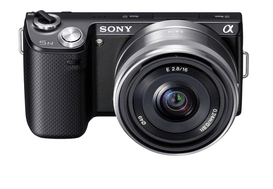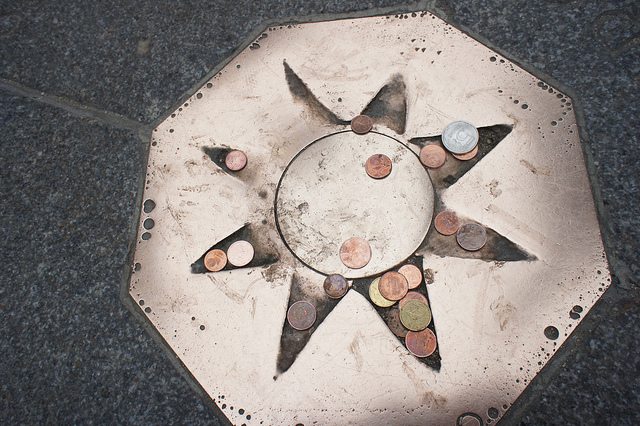
Point and shoot cameras are okay, but they really don’t take the kind of awesome photos you can get from dSLR cameras with interchangeable lenses.
At the same time, those cameras are so huge that you really have to want to take one with you. They have not only huge lenses, but a huge camera body. Even though the camera itself has moved to the digital age, the mirror has stayed as if we just slapped some electronic sensors on the back of the same camera design we’ve been using for decades. But now there’s another choice.
Let me explain a little. On dSLR cameras, the d stands for digital, and the SLR stands for Single Lens Reflex. The camera has a series of mirrors that lets you see through the lens when you look through the viewfinder, and the mirrors go up out of the way when you snap a shot to let the camera sensors record the image. You can also swap out lenses for a variety of shots or effects.
That has a couple of inconvenient side effects. It means your camera body has to be big and bulky enough to house those mirrors, and it means that although you can change lenses, you can’t always change them between brands of camera body, since some of them would require the lens to be closer to the camera in order to focus.
Enter the mirrorless cameras. There are a couple of competing technologies here. Olympus and Panasonic use what’s called “Micro Four Thirds,” and Sony uses a different system, but they work pretty similarly for us end users. You end up with a less expensive, lighter camera with what appears to be a comically oversized lens. They’ve also been around long enough that you can find sales and deals.
Mirrorless Advantages
Because there’s no mirror, the body of the camera ends up being very tiny. That means it’s easy to carry around, but it also means your adapter only needs to mount lenses away from the camera body to use them. You can find adapters for all those dSLR and SLR lenses you have around or find great deals on through eBay. You can’t use auto-focus features from a lens you’re using with an adapter, so keep that in mind before you cheer too loudly.
Because you’re not reliant on a viewfinder, you can hold your mirrorless camera out from your body or over your head and look at the display screen to make sure your photo is framed correctly. The back screen of some cameras have adjustable tilt, so you can still get a clear view of the screen from odd angles. This is fantastic for shooting photos at crowded press events, anime conventions, or science fairs.
Of the models I looked at over the summer, Sony had the smallest body. I tried several out in the store, and I went with the Sony NEX-3, even though it had a slightly less comfortable grip than the NEX-5 and has less resolution on video recording. I was actually leaning toward the NEX-5, but I happened to find an open box model for the NEX-3 at the local Best Buy. Score!

Mirrorless Disadvantages
Are your shots going to end up looking as great as they do from a fancy dSLR? Probably not. There’s still a small gap in quality, although that will probably decrease in future years. I can still take some fantastic photos, but I still end up with a few more blurry shots than I would with a dSLR, and it doesn’t perform nearly as well in low light situations. (Bad news for the convention costume contest.)
The lenses, although interchangeable, are still pretty pricey, so if you get more than one lens, as I did, you’re still looking at spending more than $200 over the initial camera price. On top of that, there’s not a huge selection of lenses being offered for these cameras right now. With Sony, there are pretty much only two choices. Hopefully they’ll announce more in January.
You’ll also find that camera accessories are designed for either point-and-shoots or for large camera bodies. My camera swims in the camera bag I used to use with my old SLR. At the same time, it’s still much larger than a point and shoot, so this isn’t something you can slip in a jacket pocket like you can with your phone or a compact point and shoot.
Video
An interesting thing seems to have happened to the video camera. I know a lot of folks who shoot video, and many of them have stopped using dedicated video cameras. You can shoot video on most (if not all) of these video cameras, and it usually ends up looking pretty great. Get a tripod and big enough memory card, and you really don’t need to buy another dedicated video camera. If you want to shoot video, look for a camera that allows you to hook up your own mic.
Bottom Line
If you’re like me and not a pro photographer, but you do need to have better quality photos, a mirrorless interchangeable lens system is a good compromise. You end up with a camera light enough to hold in one hand, and you can still get good shots. This summer when I went on vacation, I took my Sony NEX and the smaller 16mm wide-angle “pancake lens.” I stored the camera in a camera bag insert that fit inside my purse, so there was no separate camera bag to schlep around and advertise to the world that I was carrying a camera.
I handed my daughter the camera several times, and she ended up getting a purple ribbon at the county fair for this picture:

I’m not sure I’d have trusted her with a heavy dSLR, but then she’s never learned how to use a viewfinder, so I’m not sure she would have gotten the shot. In her world, cameras always use the display screen on the back, and they usually also make phone calls. Eventually, that will be our world, too.




I have been looking for a new camera and now I’ll look at these too. Thanks for the review and lesson on the differences.
PS- Congratulations to your daughter!
“Because there’s no mirror… it also means you only need to bracket lenses away from the camera body to use them. … You can’t use auto-focus features from a lens you’re using with a bracket…”
Small detail; “bracket” has a different meaning in photography: it means to take multiple shots at exposures above and below the one you think is correct, just in case your calculated exposure is off.
The “bracket” you refer to is usually called a lens adapter or an extension tube, and serves to adjust the spacing between the lens and the camera’s sensor (which, as you correctly point out, is different in a mirrorless camera than a DSLR)
You’re right. I should have been more precise in my terminology. I often bracket shots, so I do know the difference.
I’ve been using a non-slr for years now (Canon S3 IS) and love the compactness of it and that it takes decent shots (12x optical zoom). You can also get lenses for it, but I never use them! However, one drawback you didn’t mention is that you have to look at an LCD screen. You don’t get the 1:1 look you would with the SLR. In my case, my large swiveling LCD screen died ($100 to fix so I haven’t done it) and the tiny LCD viewfinder is very hard to see in bright sun. You wouldn’t have those problems with an SLR.
I keep thinking about getting an SLR but keep sticking with my S3. It’s just so convenient to take with me and 99% of the time the pictures are just fine. I imagine when my kids are older and I have time for hobbies again I will probably upgrade 🙂
Some of the Sony NEX cameras actually have an optional viewfinder.
Superzoom cameras like the Canon s3 IS are great, but they still have a narrow range of proprietary lenses they’ll take (no adapters to take standard SLR lenses), and the body is still pretty large. But then, it’s an older camera, and the next big thing is always better, right? 🙂
The Sony NEX and Micro Four Thirds cameras will take just about any standard camera lens, and they have SLR-worthy sensors in the back with a super compact body. The NEX-3 takes 14 megapixel pictures, and the NEX-7 will take 24 megapixel pictures. I figure I’ll upgrade the back on mine in the next couple years as the NEX-7 comes down in price. I like that my lenses (and all the other lenses I used to use) will be able to make the upgrade.
Interesting, I will have to look into them a little more, thanks!
You obviously know your stuff. Wish I could think of something clever to write here. Thanks for sharing.